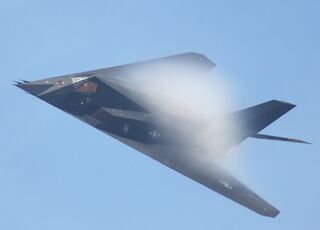
F-117A Nighthawk compressing the humidity out of the atmosphere
A steath aircraft uses stealth technology, which includes special airframes and various other technologies to prevent the enemy from tracking it, making the aircraft "invisible" to radar, infrared, audio and radio frequency spectrum. Development of stealth technology likely began in Germany on World War II, while the Germans had noticed that flying wing designs have a lower radar cross section than conventional aircraft designs. Very advanced stealth aircraft include the United States' F-117 Nighthawk (1981–2008), the B-2 Spirit, the F-22 Raptor and F-35 Lightning II.
While no aircraft is totally invisible to radar, stealth aircraft prevent conventional radar from detecting or tracking the aircraft effectively, reducing the odds of a successful attack, so that the stealth aircraft can strikie before its enemy can engage. Stealth comes from a combination of passive low observable (LO) features and active emitters such as Low Probability of Intercept Radars, radios and laser designators. These are usually combined with active defenses such as chaff, flares, and electronic countermeasures. It is accomplished by using a complex design philosophy to reduce the ability of an opponent's sensors to detect, track, or attack the stealth aircraft. This philosophy also takes into account the heat, sound, and other emissions of the aircraft as these can also be used to locate it. In other words, the principle of a stealth design "hide" the aircraft from the enemy while leaving a minimal footprint.
Full-size stealth combat aircraft demonstrators have been flown by the United States (in 1977), Russia (in 2010) and China (in 2011), while the US Armed Forces has already adopted three stealth designs, and is preparing to adopt another, the F-35 Lightning II.
Most recent fighter designs will at least claim to have some sort of stealth, low observable, reduced RCS or radar jamming capability, but as of yet there has been no actual air to air combat experience against stealth aircraft.
Methods to track an aircraft[]
1. Radar[]
This is the most conventional way to locate an aircraft- sending out radar waves, which then reflect back to their sources. Stealthy aircraft have a lot of paralleled edges to guide the radar waves away. The following aircraft utilize this technology:
- B-2 Spirit
- Boeing Bird of Prey
- Boeing X-32
- Chengdu J-20
- F-117 Nighthawk
- F-15SE Silent Eagle
- F-19
- F-35 Lightning II
- FB-22 Strike Raptor
- KAI KF-X
- Lockheed Martin F-22 Raptor
- Lockheed Martin X-35
- Lockheed Martin YF-22
- Medium Combat Aircraft
- Mitsubishi ATD-X
- Northrop YF-23
- Sukhoi PAK-FA
- Tupolev PAK-DA
2. IR-seeker (Infrared)[]
No conventional stealth aircraft can escape an IR-seeker but planes with hidden engines and downcooled thrust:
How to achieve stealthiness[]
To achieve stealthiness, a combination of different ways are used to keep radar waves from bouncing back to their origin.
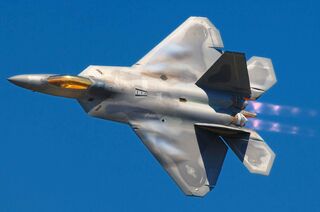
A Photo showing The Raptor's Continuous Curved Design Without having right angles.
The most sophisticated system is the use of so-called continuous curvature. Many of the surface shapes of the F/A-22 are curves with constantly changing radii. These scatter radar beams in all directions instead of back to the radar source. There are no right angles on the exterior of the design. In order to calculate the curves and the effect they have on radar reflections from any point in 3D space, requires a tremendous amount of computing power. The first plane to use this technology extensively is the B-2 stealth bomber, also known as the flying wing. Since computer- and software development has sky-rocketed over the past 20 years, prediction models can now be calculated quite precisely, taking in account radar reflection versus the shape of the plane, while supporting more naturally aerodynamic shapes. ps you can test steath shapes on your own
Planform Alignment[]
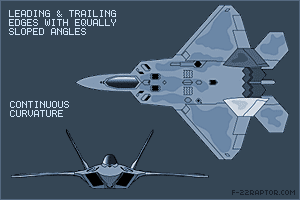
Continuos Curvature and Planform Alignment
The second way to keep radar waves from returning to the sending antenna, the leading and trailing edges of the wing and tail have identical sweep angles (a design technique called planform alignment). The fuselage and canopy have sloping sides. The vertical tails are canted. The engine face is deeply hidden by a serpentine inlet duct and weapons are carried internally. Planform alignment orients flight surfaces and small structures on the aircraft at the same angle. The result is something like a camera lens that shapes and focuses radar energy and directs it away from its detecting station.
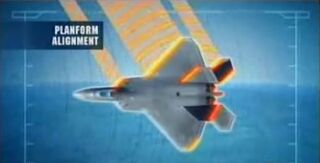
Radar Waves bounce from the Raptor away from its source through Planform Alignment
Saw-Toothed Edges[]
Stealth Aircafts must have a low height triangle appearance from the front. This physical cross sectional view ensures a small signature from the front and low observability touches such as paint and materials, as well as little "W" shapes where straight lines might have appeared, all tend to break up the signature by absorption or redirection. The "W" shapes are found at numerous places on the stealth aircraft. For instance, in the forefront of the cockpit glass, there is a very apparent "W" shape. This reduces the radar energy reflected during a head-on pass to the radar emitter. The "W" shape is also found on landing gear doors, engine inlets and outlets, as well as other openings. and a v shape
Engine Nozzles[]
Reduction of radar cross section of nozzles is also very important, and is complicated by high material temperatures. The approach taken at Lockheed is to use ceramic materials. The ceramics may be either lightweight, parasitic sheets mounted on conventional nozzle structures or heavier structural materials forming saw-toothed edges.
Cockpit[]
The pilot's head, complete with helmet, is a major source of radar return. This effect is amplified by the returns of internal bulkheads and frame members. The solution is to design the cockpit so that its external shape conforms to good low radar cross section design rules, and then plate the glass with a film similar to that used for temperature control in commercial buildings. Here, the requirements are more stringent: it should pass at least 85% of the visible energy and reflect essentially all of the radar energy. At the same time, one would prefer not to have noticeable instrument-panel reflection during night flying.
Antennas[]
On-board antennas and radar systems are a major potential source of high radar visibility for two reasons. One is that it is obviously difficult to hide something that is designed to transmit with very high efficiency, so the so-called in-band radar cross section is liable to be significant. The other is that even if this problem is solved satisfactorily, the energy emitted by these systems can normally be readily detected. The work being done to reduce these signatures is classified.
Paint Scheme[]
In order to make the F/A-22 disappear for the human eye on the ground, when in flight, special camouflage
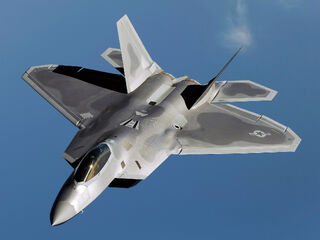
The F-22 Raptor's most common paint scheme.
schemes have been developed. This way the plane will blend with the background sky as much as possible viewed from the bottom and disappear in the ground texture when seen from above.
Conclusion[]
Decreasing the Infrared Signature caused by engine exhausts and other emissions from the aircraft should also be considered in maintaining stealth. However, no Stealth Aircraft are completely invisible to radar with the fact that even the aircraft with the stealthiest abilities can be detected and tracked through low-frequency radars.